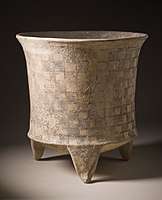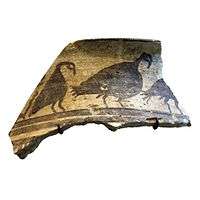Tepe Giyan
Tepe Giyan, also Tepe Gyan, is an archaeological site in the highland central Zagros mountain, in the area later known as Persia. It is mainly known for a necropolis of 19 graves. It is bears similarities with the site of Tepe Sialk, in the same general area, and its oldest ceramics are also related to the Ubaid period in Mesopotamia.[1]
 Tepe Giyan IV storage jar - End of 3rd millennium, beginning of 2nd millennium BCE. Tepe Giyan IV. | |
 Shown within Iran | |
| Location | Iran |
|---|---|
| Coordinates | 34°10′53″N 48°14′37″E |
| Type | Settlement |
| Site notes | |
| Condition | In ruins |
The phase of Giyan V (6th-4th millennium BCE) shows ceramic styles with some connections with the region of Susa.[2]
The phase of Giyan IV (End of 3rd millennium, beginning of 2nd millennium BCE) delivers ceramic in abundance. The jars are generally decorated with raised bands in horizontal and wavy raised bands. Only the neck of the jar is painted, the rest is blank. The most significant motifs in this phase are pairs of birds with wings spread in the shape of a comb and rows of sawtooth patterns.
The phase of Tepe Giyan III dates to the period 2ooo/19oo - 16oo BCE, with specific types of ceramics.[3]
The phase of Tepe Giyan I (1400 — 1100 BCE) shows that iron was still rather scarce in this site and in the areas a Persia in general at that time, with only a few daggers, spear-heads and arrow-heads, rings and bracelets being found.[4]
 Footed Urn, 3rd millennium BCE
Footed Urn, 3rd millennium BCE Potsherd ornated with bustards. Tepe Giyan, 1800-1500 BCE
Potsherd ornated with bustards. Tepe Giyan, 1800-1500 BCE
References
| Wikimedia Commons has media related to Tepe Giyan. |
- Leroux, Ernest (1953). Revue archéologique (in French). p. 116.
- Mutin, Benjamin (2012). "Cultural Dynamics in Southern Middle Asia in the fifth and fourth millennia BC: A reconstruction based on ceramic tradition". Paléorient. 38 (1): 159–184. doi:10.3406/paleo.2012.5467.
- Bellelli, Gloria M. (2002). Vasi iranici in metallo dell'Età del Bronzo (in Italian). Franz Steiner Verlag. p. 74. ISBN 978-3-515-07818-4.
- Studies in Acient Technology. Brill Archive. p. 244.